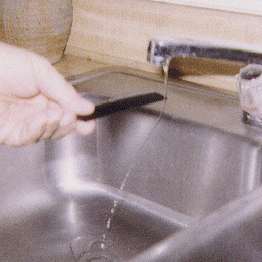The water stream will bend (curve) toward the comb. This bending occurs because the electrical field of the comb has what is called "divergence." That is, the electrical field intensity decreases as the distance from the comb increases. (The electrical lines of force are not parallel.) Water molecules, which are electrical dipoles, tend to orient themselves so that their dipoles are in line with the field lines of the comb's charge. Since the comb's field intensity decreases with distance, the ends of the water molecules which are closer to the comb will experience a greater force of (so-called)* attraction than the repulsion experienced by their opposite ends. In this "tug-of-war" the comb-side charges win, and the water stream departs from vertical.
*See the author's article which purports to explain how all electrical forces are actually repulsive, but like-charges repel each other more than unlike-charges.
